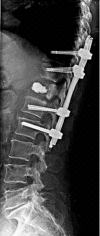Percutaneous minimally invasive versus open spine surgery in the treatment of fractures of the thoracolumbar junction: a comparative effectiveness review
- PMID: 23526905
- PMCID: PMC3592764
- DOI: 10.1055/s-0032-1327809
Percutaneous minimally invasive versus open spine surgery in the treatment of fractures of the thoracolumbar junction: a comparative effectiveness review
Abstract
Study design: Comparative effectiveness review.
Objective: To determine the comparative effectiveness and safety of percutaneous minimally invasive versus open spine surgery for fractures of the thoracolumbar junction.
Methods: A systematic review of the English-language literature was undertaken for articles published between 1970 and March 15, 2012. Reference lists of key articles were also systematically checked. We attempted to identify all articles that reported on the effectiveness and/or safety comparing minimally invasive surgery (MIS) with open surgery for thoracolumbar fractures in the adult population. Articles containing hematological or neoplastic fractures primarily were excluded. Other exclusions included reviews, editorials, case series, non-English-language written studies, and animal studies. We rated the overall body of evidence using a modified Grades of Recommendation Assessment, Development and Evaluation (GRADE) system for diagnostic and therapeutic studies.
Results: • Two studies (Level of Evidence III) met our inclusion criteria. • Radiographic outcomes were similar between treatment groups. • Postoperative incisional pain was less in patients undergoing percutaneous MIS. • Patient function as assessed by the Hannover Spine Score, the SF-36 and the MacNab criteria were slightly higher in the percutaneous minimally invasive group, but not statistically significant. • Percutaneous MIS resulted in less blood loss and shorter length of hospital stay than open surgery. • No complications were reported using percutaneous MIS.
Conclusion: Limited data suggest that percutaneous techniques are associated with less postoperative pain, less blood loss, a shorter hospital stay, and a slightly better functional outcome. However, concerns remain on the effectiveness of percutaneous techniques in correcting spinal deformity and achieving bony fusion. Further studies are needed to verify these preliminary findings.
Figures





References
-
- Hu R, Mustard C A, Burns C. Epidemiology of incident spinal fracture in a complete population. Spine (Phila Pa 1976) 1996;21(4):492–499. - PubMed
-
- Ostelo R W, de Vet H C. Clinically important outcomes in low back pain. Best Pract Res Clin Rheumatol. 2005;19(4):593–607. - PubMed
-
- Wild M H, Glees M, Plieschnegger C. et al.Five-year follow-up examination after purely minimally invasive posterior stabilization of thoracolumbar fractures: a comparison of minimally invasive percutaneously and conventionally open treated patients. Arch Orthop Trauma Surg. 2007;127(5):335–343. - PubMed
-
- Wang H W, Li C Q, Zhou Y. et al.Percutaneous pedicle screw fixation through the pedicle of fractured vertebra in the treatment of type A thoracolumbar fractures using Sextant system: an analysis of 38 cases. Chin J Traumatol. 2010;13(3):137–145. - PubMed
LinkOut - more resources
Full Text Sources
Other Literature Sources
Miscellaneous

